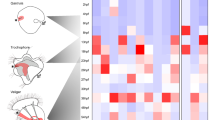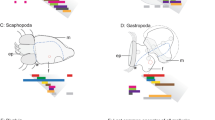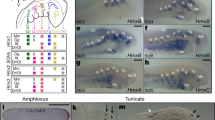Abstract
Hox genes exert fundamental roles for proper regional specification along the main rostro-caudal axis of animal embryos. They are generally expressed in restricted spatial domains according to their position in the cluster (spatial colinearity)—a feature that is conserved across bilaterians. In jawed vertebrates (gnathostomes), the position in the cluster also determines the onset of expression of Hox genes (a feature known as whole-cluster temporal colinearity (WTC)), while in invertebrates this phenomenon is displayed as a subcluster-level temporal colinearity. However, little is known about the expression profile of Hox genes in jawless vertebrates (cyclostomes); therefore, the evolutionary origin of WTC, as seen in gnathostomes, remains a mystery. Here, we show that Hox genes in cyclostomes are expressed according to WTC during development. We investigated the Hox repertoire and Hox gene expression profiles in three different species—a hagfish, a lamprey and a shark—encompassing the two major groups of vertebrates, and found that these are expressed following a whole-cluster, temporally staggered pattern, indicating that WTC has been conserved during the past 500 million years despite drastically different genome evolution and morphological outputs between jawless and jawed vertebrates.
This is a preview of subscription content, access via your institution
Access options
Access Nature and 54 other Nature Portfolio journals
Get Nature+, our best-value online-access subscription
$29.99 / 30 days
cancel any time
Subscribe to this journal
Receive 12 digital issues and online access to articles
$119.00 per year
only $9.92 per issue
Buy this article
- Purchase on Springer Link
- Instant access to full article PDF
Prices may be subject to local taxes which are calculated during checkout




Similar content being viewed by others
References
Pearson, J. C., Lemons, D. & McGinnis, W. Modulating Hox gene functions during animal body patterning. Nat. Rev. Genet. 6, 893–904 (2005).
Garcia-Fernàndez, J. The genesis and evolution of homeobox gene clusters. Nat. Rev. Genet. 6, 881–892 (2005).
Pascual-Anaya, J., D’Aniello, S., Kuratani, S. & Garcia-Fernandez, J. Evolution of Hox gene clusters in deuterostomes. BMC Dev. Biol. 13, 26 (2013).
Smith, J. J. & Keinath, M. C. The sea lamprey meiotic map improves resolution of ancient vertebrate genome duplications. Genome Res. 25, 1081–1090 (2015).
Dehal, P. & Boore, J. L. Two rounds of whole genome duplication in the ancestral vertebrate. PLoS Biol. 3, e314 (2005).
Putnam, N. H. et al. The amphioxus genome and the evolution of the chordate karyotype. Nature 453, 1064–1071 (2008).
Van de Peer, Y., Maere, S. & Meyer, A. The evolutionary significance of ancient genome duplications. Nat. Rev. Genet. 10, 725–732 (2009).
Van de Peer, Y., Maere, S. & Meyer, A. 2R or not 2R is not the question anymore. Nat. Rev. Genet. 11, 166 (2010).
Kuraku, S., Meyer, A. & Kuratani, S. Timing of genome duplications relative to the origin of the vertebrates: did cyclostomes diverge before or after? Mol. Biol. Evol. 26, 47–59 (2009).
Mehta, T. K. et al. Evidence for at least six Hox clusters in the Japanese lamprey (Lethenteron japonicum). Proc. Natl Acad. Sci. USA 110, 16044–16049 (2013).
Smith, J. J. et al. Sequencing of the sea lamprey (Petromyzon marinus) genome provides insights into vertebrate evolution. Nat. Genet. 45, 415–421 (2013).
Seo, H. C. et al. Hox cluster disintegration with persistent anteroposterior order of expression in Oikopleura dioica. Nature 431, 67–71 (2004).
Dollé, P., Izpisúa-Belmonte, J. C., Falkenstein, H., Renucci, A. & Duboule, D. Coordinate expression of the murine Hox-5 complex homoeobox-containing genes during limb pattern formation. Nature 342, 767–772 (1989).
Izpisúa-Belmonte, J. C., Falkenstein, H., Dollé, P., Renucci, A. & Duboule, D. Murine genes related to the Drosophila AbdB homeotic genes are sequentially expressed during development of the posterior part of the body. EMBO J. 10, 2279–2289 (1991).
Wang, S. et al. Scallop genome provides insights into evolution of bilaterian karyotype and development. Nat. Ecol. Evol. 1, 0120 (2017).
Takio, Y. et al. Hox gene expression patterns in Lethenteron japonicum embryos—insights into the evolution of the vertebrate Hox code. Dev. Biol. 308, 606–620 (2007).
Stadler, P. F. et al. Evidence for independent Hox gene duplications in the hagfish lineage: a PCR-based gene inventory of Eptatretus stoutii. Mol. Phylogenet. Evol. 32, 686–694 (2004).
Dean, B. On the Embryology of Bdellostoma stouti: A General Account of Myxinoid Development from the Egg and Segmentation to Hatching 220–276 (G. Fischer, Jena, 1899).
Oisi, Y., Ota, K. G., Kuraku, S., Fujimoto, S. & Kuratani, S. Craniofacial development of hagfishes and the evolution of vertebrates. Nature 493, 175–180 (2013).
Smith, J. J., Baker, C., Eichler, E. E. & Amemiya, C. T. Genetic consequences of programmed genome rearrangement. Curr. Biol. 22, 1524–1529 (2012).
Kohno, S.-i., Kubota, S. & Nakai, Y. in The Biology of Hagfishes (eds Mørup Jørgensen, J. et al.) 81–100 (Springer Netherlands, Dordrecht, 1998).
Kuraku, S. Impact of asymmetric gene repertoire between cyclostomes and gnathostomes. Semin. Cell Dev. Biol. 24, 119–127 (2013).
Ohno, S. Evolution by Gene Duplication (Springer, New York, 1970).
Kasahara, M. The 2R hypothesis: an update. Curr. Opin. Immunol. 19, 547–552 (2007).
Martin, K. J. & Holland, P. W. Enigmatic orthology relationships between Hox clusters of the African butterfly fish and other teleosts following ancient whole-genome duplication. Mol. Biol. Evol. 31, 2592–2611 (2014).
Takio, Y. et al. Evolutionary biology: lamprey Hox genes and the evolution of jaws. Nature 429, https://doi.org/10.1038/nature02616 (2004).
Schiemann, S. M. et al. Clustered brachiopod Hox genes are not expressed collinearly and are associated with lophotrochozoan novelties. Proc. Natl Acad. Sci. USA 114, E1913–E1922 (2017).
Parker, H. J., Bronner, M. E. & Krumlauf, R. A. Hox regulatory network of hindbrain segmentation is conserved to the base of vertebrates. Nature 514, 490–493 (2014).
Kuratani, S., Horigome, N., Ueki, T., Aizawa, S. & Hirano, S. Stereotyped axonal bundle formation and neuromeric patterns in embryos of a cyclostome, Lampetra japonica. J. Comp. Neurol. 391, 99–114 (1998).
Oulion, S. et al. Evolution of repeated structures along the body axis of jawed vertebrates, insights from the Scyliorhinus canicula Hox code. Evol. Dev. 13, 247–259 (2011).
Wingate, R. J. The rhombic lip and early cerebellar development. Curr. Opin. Neurobiol. 11, 82–88 (2001).
Murakami, Y. et al. Segmental development of reticulospinal and branchiomotor neurons in lamprey: insights into the evolution of the vertebrate hindbrain. Development 131, 983–995 (2004).
Kuraku, S. et al. Noncanonical role of Hox14 revealed by its expression patterns in lamprey and shark. Proc. Natl Acad. Sci. USA 105, 6679–6683 (2008).
Tahara, Y. Normal stages of development in the lamprey, Lampetra reissneri (Dybowski). Zool. Sci. 5, 109–118 (1988).
Ballard, W. W., Mellinger, J. & Lechenault, H. A series of normal stages for development of Scyliorhinus canicula, the lesser spotted dogfish (Chondrichthyes: Scyliorhinidae). J. Exp. Zool. 267, 318–336 (1993).
Ikuta, T., Yoshida, N., Satoh, N. & Saiga, H. Ciona intestinalis Hox gene cluster: its dispersed structure and residual colinear expression in development. Proc. Natl Acad. Sci. USA 101, 15118–15123 (2004).
Yang, K. Y. et al. Transcriptome analysis of different developmental stages of amphioxus reveals dynamic changes of distinct classes of genes during development. Sci. Rep. 6, 23195 (2016).
Pascual-Anaya, J. et al. Broken colinearity of the amphioxus Hox cluster. EvoDevo 3, 28 (2012).
Deschamps, J. & Duboule, D. Embryonic timing, axial stem cells, chromatin dynamics, and the Hox clock. Genes Dev. 31, 1406–1416 (2017).
Aronowicz, J. & Lowe, C. J. Hox gene expression in the hemichordate Saccoglossus kowalevskii and the evolution of deuterostome nervous systems. Integr. Comp. Biol. 46, 890–901 (2006).
Gonzalez, P., Uhlinger, K. R. & Lowe, C. J. The adult body plan of indirect developing hemichordates develops by adding a Hox-patterned trunk to an anterior larval territory. Curr. Biol. 27, 87–95 (2017).
Duboule, D. The rise and fall of Hox gene clusters. Development 134, 2549–2560 (2007).
Oisi, Y., Kakitani, O., Kuratani, S. & Ota, K. G. in In Situ Hybridization Methods (ed. Hauptmann, G.) 249–262 (Springer, New York, 2015).
Sugahara, F. et al. Evidence from cyclostomes for complex regionalization of the ancestral vertebrate brain. Nature 531, 97–100 (2016).
Sugahara, F., Murakami, Y. & Kuratani, S. in In Situ Hybridization Methods (ed. Hauptmann, G.) 263–278 (Springer, New York, 2015).
Sultan, M. et al. A simple strand-specific RNA-Seq library preparation protocol combining the Illumina TruSeq RNA and the dUTP methods. Biochem. Biophys. Res. Commun. 422, 643–646 (2012).
Chevreux, B., Wetter, T. & Suhai, S. Genome Sequence Assembly Using Trace Signals and Additional Sequence Information. In Computer Science and Biology: Proceedings of the German Conference on Bioinformatics 45–56 (GCB, 1999).
Grabherr, M. G. et al. Full-length transcriptome assembly from RNA-Seq data without a reference genome. Nat. Biotechnol. 29, 644–652 (2011).
Li, W. & Godzik, A. Cd-hit: a fast program for clustering and comparing large sets of protein or nucleotide sequences. Bioinformatics 22, 1658–1659 (2006).
Xie, Y. et al. SOAPdenovo-Trans: de novo transcriptome assembly with short RNA-Seq reads. Bioinformatics 30, 1660–1666 (2014).
Kim, D., Langmead, B. & Salzberg, S. L. HISAT: a fast spliced aligner with low memory requirements. Nat. Methods 12, 357–360 (2015).
Haas, B. J. et al. Improving the Arabidopsis genome annotation using maximal transcript alignment assemblies. Nucleic Acids Res. 31, 5654–5666 (2003).
Hara, Y. et al. Optimizing and benchmarking de novo transcriptome sequencing: from library preparation to assembly evaluation. BMC Genom. 16, 977 (2015).
Huang, S. et al. Decelerated genome evolution in modern vertebrates revealed by analysis of multiple lancelet genomes. Nat. Commun. 5, 5896 (2014).
Martin, M. Cutadapt removes adapter sequences from high-throughput sequencing reads. EMBnet. J. 17, 10–12 (2011).
Macmanes, M. D. On the optimal trimming of high-throughput mRNA sequence data. Front. Genet. 5, 13 (2014).
Wild, J., Hradecna, Z. & Szybalski, W. Conditionally amplifiable BACs: switching from single-copy to high-copy vectors and genomic clones. Genome Res. 12, 1434–1444 (2002).
Bouzidi, M. F. et al. A sunflower BAC library suitable for PCR screening and physical mapping of targeted genomic regions. Theor. Appl. Genet. 113, 81–89 (2006).
Huddleston, J. et al. Reconstructing complex regions of genomes using long-read sequencing technology. Genome Res. 24, 688–696 (2014).
Luo, R. et al. SOAPdenovo2: an empirically improved memory-efficient short-read de novo assembler. GigaScience 1, 18 (2012).
Simpson, J. T. et al. ABySS: a parallel assembler for short read sequence data. Genome Res. 19, 1117–1123 (2009).
Kurtz, S. et al. Versatile and open software for comparing large genomes. Genome Biol. 5, R12 (2004).
Camacho, C. et al. BLAST+: architecture and applications. BMC Bioinformatics 10, 421 (2009).
Nowicki, J. L., Takimoto, R. & Burke, A. C. The lateral somitic frontier: dorso-ventral aspects of anterio-posterior regionalization in avian embryos. Mech. Dev. 120, 227–240 (2003).
Amemiya, C. T. et al. The amphioxus Hox cluster: characterization, comparative genomics, and evolution. J. Exp. Zool. B Mol. Dev. Evol. 310, 465–477 (2008).
Holland, L. Z. et al. The amphioxus genome illuminates vertebrate origins and cephalochordate biology. Genome Res. 18, 1100–1111 (2008).
Pascual-Anaya, J., D’Aniello, S. & Garcia-Fernàndez, J. Unexpectedly large number of conserved noncoding regions within the ancestral chordate Hox cluster. Dev. Genes Evol. 218, 591–597 (2008).
Katoh, K. & Standley, D. M. MAFFT multiple sequence alignment software version 7: improvements in performance and usability. Mol. Biol. Evol. 30, 772–780 (2013).
Castresana, J. Selection of conserved blocks from multiple alignments for their use in phylogenetic analysis. Mol. Biol. Evol. 17, 540–552 (2000).
Hall, T. A. BioEdit: a user-friendly biological sequence alignment editor and analysis program for Windows 95/98/NT. Nucleic Acids Symp. Ser. 41, 95–98 (1999).
Stamatakis, A. RAxML version 8: a tool for phylogenetic analysis and post-analysis of large phylogenies. Bioinformatics 30, 1312–1313 (2014).
Li, B. & Dewey, C. N. RSEM: accurate transcript quantification from RNA-Seq data with or without a reference genome. BMC Bioinformatics 12, 323 (2011).
Warnes, G. R. et al. gplots: Various R Programming Tools for Plotting Data R package version 3.0.1 (2016).
RStudio Team RStudio: Integrated Development for R (2016).
R Development Core Team R: A Language and Environment for Statistical Computing (R Foundation for Statistical Computing, Vienna, 2016).
Nicolae, M. & Măndoiu, I. in Bioinformatics Research and Applications: Proc. 7th Int. Symp. ISBRA 2011. Lecture Notes in Computer Science Vol. 6674 (eds Chen, J., Wang, J. & Zelikovsky, A.) 392–403 (Springer, Berlin & Heidelberg, 2011).
Acknowledgements
We thank Y. Oisi and S. Fujimoto for providing preliminary hagfish Hox gene sequences, J. M. Martín-Durán, I. Maeso, M. Irimia and C. Böhmer for fruitful discussions, O. Kakitani for hagfish sampling, K. Shirato for shark sampling, S. Shibuya and K. Yamamoto for maintenance of aquarium tanks, S. Kuraku, K. Itomi, C. Tanegashima, K. Tatsumi and O. Nishimura at the Phyloinformatics Unit, RIKEN Center for Life Science Technologies for RNA-seq data production, J. Huddleston and E. Eichler for providing the code to mask BAC vector sequences from PacBio reads, I. Măndoiu for help using DGE-EM software, and B. Chevreaux for help with the MIRA assembler. This work was supported by the Chinese Academy of Sciences programme XDB13000000 to W.W., a Grant-in-Aid for Scientific Research (A) 15H02416 (Japan Society for the Promotion of Science), a Grant-in-Aid for Scientific Research on Innovative Areas (Research in a Proposed Research Area) 17H06384 (Ministry of Education, Culture, Sports, Science and Technology of Japan) and a Naito Grant for the Promotion of Focused Research (The Naito Foundation) to S.K. A.R.-V. holds a ‘Juan de la Cierva’ postdoctoral contract (Ministerio de Economía y Competitividad of Spain).
Author information
Authors and Affiliations
Contributions
J.P.-A. conceived the project, designed the experiments and wrote the paper. J.P.-A., F.S., S.H. and W.T. obtained the hagfish embryos. J.P.-A., I.S., F.S., S.H., W.T. and A.R.-V. performed the experiments. K.G.O. built the BAC library. Y.R. and W.W. sequenced and assembled the E. burgeri draft genome. J.P. performed the phylogenetic analyses. All authors analysed and discussed the data. All authors approved the final version of the manuscript.
Corresponding author
Ethics declarations
Competing interests
The authors declare no competing interests.
Additional information
Publisher’s note: Springer Nature remains neutral with regard to jurisdictional claims in published maps and institutional affiliations.
Supplementary information
Supplementary Information
Supplementary Figures 1–10, Supplementary Tables 1–3.
Supplementary Table 4
Accession numbers of sequences used for phylogenetic analyses
Rights and permissions
About this article
Cite this article
Pascual-Anaya, J., Sato, I., Sugahara, F. et al. Hagfish and lamprey Hox genes reveal conservation of temporal colinearity in vertebrates. Nat Ecol Evol 2, 859–866 (2018). https://doi.org/10.1038/s41559-018-0526-2
Received:
Accepted:
Published:
Issue Date:
DOI: https://doi.org/10.1038/s41559-018-0526-2
This article is cited by
-
The hagfish genome and the evolution of vertebrates
Nature (2024)
-
Genomic reconsideration of fish non-monophyly: why cannot we simply call them all ‘fish’?
Ichthyological Research (2024)
-
Hagfish genome elucidates vertebrate whole-genome duplication events and their evolutionary consequences
Nature Ecology & Evolution (2024)
-
Comparative analysis of Hmx expression and the distribution of neuronal somata in the trigeminal ganglion in lamprey and shark: insights into the homology of the trigeminal nerve branches and the evolutionary origin of the vertebrate jaw
Zoological Letters (2023)
-
Comparative expression analysis of the Atoh7 gene regulatory network in the mouse and chicken auditory hindbrain
Cell and Tissue Research (2023)



